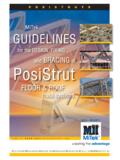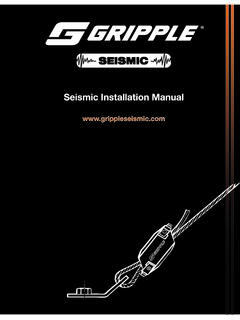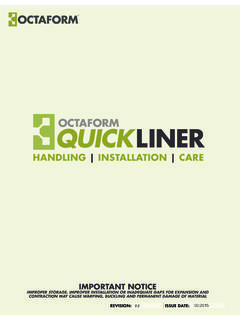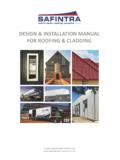Transcription of Roof Systems Manual - Kattoliitto
1 roof Systems Manual2A good roof the most important facade 5A roof is of primary importance 6 roof system regulations and guidelines 6CE marking of construction products 6 Product and contracting certificate 6 Low Pitched Roofs Design of low pitched roofsLife span of a roof 7 roof structures 7 Air barrier 7 Vapour barrier 7 Recommended vapour barriers 7 Vapour barrier to be specified according to prevailing conditions 7 Ventilated roof structures 8 Ventilated voidless structures 8 Unventilated roof structures 8 Pressurised roof construction 8 Warm roofs 8 Inverted roofs 8 roof decking 9 Timber substructure 9 Board decking 9 Timber panel decking 9 Concrete decks 9 Insulation slab substrate 9 Mineral wool 10 Plastic insulation slabs 10 Cellular glass 10 Roofing Systems Bitumen membranes 11 Two-ply roofing 11 Single-ply roofing 11 Rating of bitumen membranes 11 Use classification of bitumen membranes 11 Fire rating 14 The Finnish Roofing Association s recommendations for constructing fire breaks 14 Properties of bitumen adhesives 14 Other membranes 14 Fixing of membrane roofing General 15 Bonding with bitumen 15 Mechanical fastening 15 Fastening to timber decking 15 Fastening to concrete decking 15 Fastening to insulation slabs 15 Details Penetrations 16 Joining penetrations to roofing 16 roof drains 16 Rainwater scupper 16 Lead-through collars 16 Suction ventilators 16 roof bollards 17 Upturns 17 Eaves 17 Valleys 17 Movement joints 17 Trafficked areas.
2 Outdoor decks and terraces Thermally insulated structures 18 Inverted roof structure 18 Upturns in inverted structures 18 roof drains in inverted structures 19 Other penetrations through an inverted structure 19 Enclosed structure 19 Cold decks 19 Green Roofs 19 Bridges 19 Contents3 Renovation of low pitched roofs Surveying the condition of a roof 20 Refurbishment plan 20 Conventional roofing repair options 21 Reroofing over the existing membrane 21 Removal of old roofing 21 Adjusting the roof fall 21 The repair of a sheetmetal roof with bitumen membranes 21 Construction of low pitched roofs Hot work regulations 22 Hot work permit 22 Hot Work Permission / Checklist for Hot Work 22 Hot work supervision plan 22 Safety at work 22 Protection against falling 22 Access routes 22 Canopies 22 General tidiness and order 23 Equipment 23 Propane equipment 23 Propane hand torches 23 Bitumen boilers 23 Hot air guns 23 Working conditions and protection during construction 23 Installation of vapour barrier 24 Installation of insulation 24 Installing bitumen membranesFixing methods 25 Bonding with adhesive 25 Torching 25 Fixing the cap sheet 26 Mechanical fixing 26 Overlaps 26 Installing PVC roofing 27 Quality requirements of contracted work 28 Detail Drawings (Low pitch roofs)
3 30 High pitched roofChoosing your roofing 37 roof structures 37 roof ventilation 37 roof pitches 37 Air and vapour barrier 38 Underlays 38 The classification of underlays 38 Fixings 40 Penetrations and wall joints 40 Rainwater Systems 40 roof safety products 40 Safety at work 40 Maintenance 40 Bitumen roofings on steep roofs General 41 Decking 41 Ventilation 42 Fixing 42 Eaves and verges 42 Penetrations and wall upturns 42 Bitumen roofing shinglesGeneral 43 roof pitches and underlays 43 Eaves and verges 43 Installation of roofing shingles 43 Valleys 43 Ridge and hips 43 Penetration weatherproofing and other upturns 43 Bitumen roofing with upstand sidelaps General 44 roof pitches and underlays 44 Eaves and verges 44 Traditional bitumen roofing with upstand sidelaps 44 Valleys 44 Ridge 44 Weatherproofing of penetrations 44 Modern upturn sidelap roofing 45 Continuous roofing systemsGeneral 46 Self-adhesive bitumen membranes 46 Gluable bitumen membranes 46 Cold bonding Systems 46 Hot bonding Systems 46 Torch-on bitumen membranes 46 Quality requirements of bitumen roofing 46 Detail Drawings (Bitumen roofing system ) 47 Sheetmetal roofs General 50 Design 50 General 50 roof pitches 50 roof deck 50 Ventilation 51 Details 51 Coatings 51 Profiled sheetmetal roofsGeneral 52 Substructure 52 Fixings 52 Implementation 52 Dimensions 52 Installing the underlay 52 Installation of purlins 53 Installation of barge boards 53 Valley 53 Installation of profiled sheetmetal roofing 53 Flashings (upturns) 54 Verge trim 54 Ridge capping (ridge and hips)
4 54 Installation of roof access hatch 54 Weatherproofing of penetrations 54 Chimney flashing 54 Long strip roofing with welted seams General 55 roof deck 55 Sheetmetal strips, seams and fixing. 55 Curb gutters and penetrations 55 Upturns 55 Quality requirements: Pressed panels and corrugated roofings 56 Quality requirements of long strip sheetmetal roofing 57 Detail Drawings (Sheetmetal roofs) 58 Tiled roofs Fired clay tile roofing 63 Concrete tile roofing 63 Design 63 roof pitch 63 Supporting structure 63 Underlay for concrete tile roofing 63 Underlay for clay tile roofing 63 Loadbearing structure 64 Execution 64 Installation of tiled roof 64 Installing the underlay 64 Installation of tile battens 64 Installation of roof tiles 64 Nailing 64 Details 64 Eave 64 Verge 65 Valley 65 Hip 65 Ridge 65 Penetrations and upturns at wall abutments 65 roof hatch 66 roof safety fittings 66 Quality requirements 66 Detail Drawings (Tiled roofs)
5 67 Contract procedure 70 Maintenance 73 The Finnish Roofing Association 74 Roofing and waterproofing regulations and guidelines 75 The members of the Finnish Roofing Association 76 A good roof the most important facadeBuildings constitute a major part of the Finnish national wealth. We simply cannot afford its premature decay. A healthy building can only exist under a well functioning roof . A correctly designed and well executed roof system means the preservation of our national wealth and natural resources, and implies appreciation of sound professional decisions made at three separate stages infl uence the life span of a roof : during its design, during the actual execution of the work and during its service the design stage we set a goal for the life span of a roof and this has implications for the design of its structural system and details as well as for the choice of the execution of the actual work.
6 The roof is constructed according to design specifi cations and applying the good building practices and generally approved installation meth-ods of the roofi ng and suffi ciently frequent maintenance during the service life plays a critical role in the durability and function-ing of a roofi ng projected life span of a roof can only be realised when all the stages of the roof s life cycle are executed correctly and in a predetermined roof Systems Manual is based on the long standing experience and expertise of roofi ng professionals and provides the tools to execute and perform these stages applies not only to roofs. All other waterproofi ng must be designed and executed according to the above principles. This is the only way to ensure that the whole design life span of the building can be attained in the desired Roofi ng Systems Manual now covers more ground than everThe Finnish Roofi ng Association has for decades done work towards better roofs, and the Roofi ng Systems Manual has been an important tool in implementing this goal.
7 This Manual presents the association members' shared view of how to attain a sound and well functioning roof or other waterproofi ng Roofi ng Systems Manual is based on the experience and expertise of roofi ng contractors and material to the progress made in the association's activities and development of the member base, the Manual s contents cover a wider range than ever before. It is divided into two parts according to roof shape, Low Pitched Roofs and High Pitched Roofs, of which the latter is sub-divided into three main sections, depending on the roofi ng material: bitumen roofi ng Systems , metal roofs and tiled roofs. The section Low Pitched Roofs also includes various structural solutions relating to waterproofi ng in different parts of a Roofi ng Systems Manual is a tool for good roofi ngApart from being an expression of expert opinion, this publication is a useful tool for all who are involved in roof construction or repairs for professional contractors and clients Finnish Roofi ng Association s objective in publishing this Manual is to encourage the parties involved in construction to design, execute.
8 Buy and demand good and well function-ing roofs and other waterproofi ng Systems that will retain their integrity for their design Roofi ng Systems Manual is updated as required and the latest version is available on the website of the Finnish Roofi ng Association at including a list of dated Roofi ng Association Mikko AhtolaCEO6 The roof is a system that separates the building's top floor from the outdoor environment. It consists of functional parts, which have to work together: supporting structure air barrier vapour barrier insulation ventilated space if appropriate decking for roofing actual roofing water drainage penetrations other auxiliary roof structuresRoof system regulations and guidelinesStructural design and the use of products in construction are regulated by EU building product directives, harmonised product stand-ards, national building codes, The National Building Code of Finland and voluntary guidelines such as the roof Systems Manual , the RT construction file, water and moisture-proofing code of practice (RIL 107)
9 , RYL 2000 on the quality requirements in the construc-tion industry as well as the product and contracting certificates given by VTT Technical Research Centre of Finland, all of which illustrate good building practices to be adhered to in marking of construction productsBy CE marking of construction products the manufacturer attests that the product complies with all the applicable EU directives. However, CE marking alone does not guarantee that the product is suitable for use in Finland. Product and contracting certificateVTT Technical Research Centre of Finland has approved a general code of conduct CERTIFICATION CRITERIA FOR BUILT-UP BITUMEN roof -ING Systems . VTT and the roofing industry have together specified the requirements contained in the objective of the guideline is to ensure the suitability of roofs built for Finnish conditions and to facilitate the choice of methods and materials at dif-ferent stages of the construction first section of the two-part guideline provides the specifications for built-up bitumen roofing required in Finnish climate conditions.
10 Built-up roofing Systems certified according to the specified criteria are suitable for use in Finland independent of the second part of the guideline defines the requirements for roofing work, accessories and obtain a certificate granted by VTT a contractor must undertake to fulfil the requirements of both parts of the above publication as applies to both their activities and materials roof is of primary importance7 Low Pitched RoofsRoofs with a pitch of 1:10 or less can be considered low pitched roofs. The basis for the design should be that the required falls are already incorporated in the structure. Roofs with a pitch of less than 1:80 should not be designed. Roofings and the related detailing of low pitched roofs should be such as to withstand water of low pitched roofsDesign of the waterproofing system must be made and these should include its construction and detailing, specification of materials and accesso-ries, the fixing method and the fixings to be used, the joining of waterproof-ing and other structures, and drainage.





